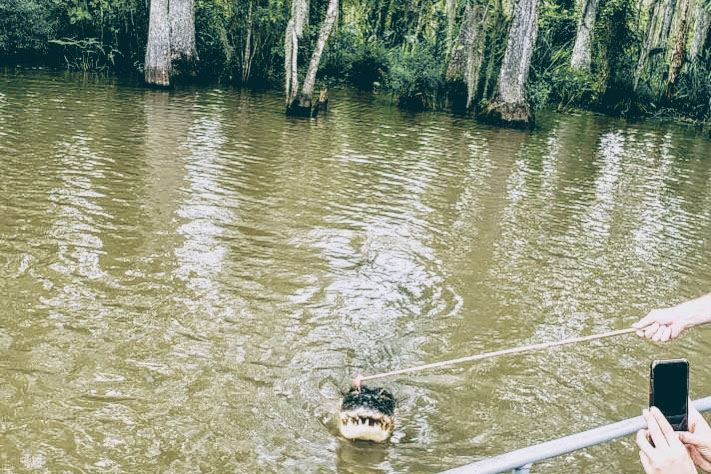Senior embraces culture on summer trip
A group of tourists feeds an alligator a hot dog during a swamp tour on the outskirts of New Orleans.
August 29, 2019
A sea of people cascade in waves down the paved streets while neon street signs glitter in the moonlit glow of midnight jazz. In the wake of gleaming tail lights, blaring horns and Cajun accents divide the chaos. New Orleans leaves a mark on all who visit. I went to New Orleans, commonly called Nola, for my summer trip. Beneath the crumbled chaos of the city, there is a serene, southern charm that surrounds the people of the metropolis.
I debated writing this story, confused with writer’s block and overwhelmed with chaotic thoughts of why it even mattered. I found that I was overlooking something key, an aspect of the city that makes it unique; culture is the key component. Beyond the tourist grips of Cafe Du Monde, the French Quarter and the mossy swamps, lies a culmination of remarkable history.
Throughout my travels, I participated in a ghost tour, a tour of Oak Alley Plantation, a swamp tour and a cemetery tour. I learned how the cultures of the African slaves and white Europeans blended to create voodoo – a belief system that the famous Marie Laveau practiced. Not only were new practices developed between the culture exchange, food also was altered and created. Who knew there are two types of gumbo, Cajun and Creole – which are made entirely different – that derived from separate parts of Louisiana?
Oak Alley Plantation, although sickening, was a reminder of the terrible history this country endured. Walking through the exhibits was heart-wrenching knowing that hundreds of innocent people were either murdered or tortured and deprived of inalienable human rights. A history of fear that will never be forgotten lives in the city. Delphine Lalaurie, a revolting french woman, tortured hundreds of her slaves in twisted human experiments. Her story lives on in her home in the French Quarter, as people say it’s haunted by her ghost as well as her various victims’ spirits.
The swamps of Louisiana, filled with alligators, wild hogs, various plants and insects, frogs and raccoons, are also a large aspect of Nola’s culture. The Louisiana Department of Wildlife and Fisheries has specialized programs for various animals such as alligators, black bears and snakes. Swamp tours are a large tourist attraction and on the tour the tour guides feed the “gators” hot dogs as well as stroke their heads. It’s gorgeous to see the soft, untouched mosses drift soundly in the murky water while the sounds of insects buzz against the trees. The swamp is a humbling reverie in the midst of the chaotic city.
Before writing this, I didn’t realize the point of it – why I needed to write this story. It’s the chaotic, horrendous, beautiful and humbling culture that built New Orleans. The people of New Orleans continue to paint it and make it worthwhile. The coalition of culture is the reason why the city thrives so marvelously.







